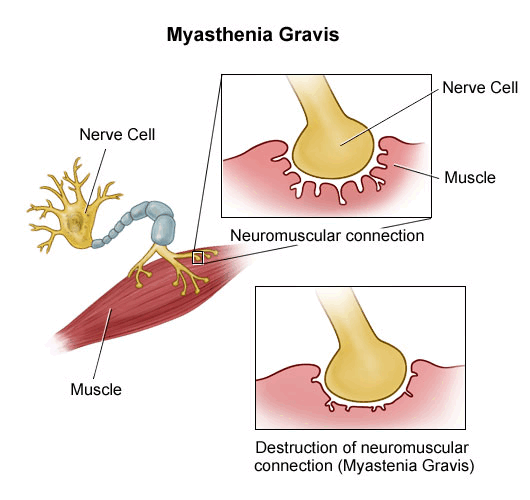Myasthenia Gravis
Myasthenia gravis is a clinical condition where antibodies are generated within the body that attack the junctions between the nerves and the muscles, resulting in muscle weakness and tiredness. At the junction of the nerves and muscles (also called neuromuscular junction) are receptors called acetylcholine receptors. These receptors have the capability of binding to acetylcholine, a neurotransmitter that helps promote conduction of electrical impulses from the nerves to the muscle. Blocking of these in myasthenia gravis is what results in the clinical features.
In this article, we shall briefly discuss the signs and symptoms of myasthenia gravis, and touch upon the different management options available.
Clinical features
Patients with myasthenia gravis experience the typical feature of muscle fatigue. The muscles become weaker with time, and are particularly vulnerable when undergoing continuous activity. One of the muscle groups that are often involved is the eyelid. Patients have droopy eyelids - a condition called ptosis. This can affect one or both of the eyelids and can have additional effects such as double vision. This is called ocular myasthenia.
Other symptoms that could be seen include slurred speech, difficulty walking, weakness of the muscles of the arms and legs, difficulty swallowing and even muscles that are required for breathing (in advanced cases).
Pathophysiology
The main underlying defect in myasthenia gravis (as described briefly above) is autoimmunity. This means that there are antibodies within the body that act against the individual’s own proteins. These antibodies are called auto-antibodies. There is some genetic link in myasthenia, though in most cases the underlying abnormality lies within a gland in the chest called the thymus gland. The auto-antibodies act against the acetylcholine receptor, thus interrupting normal neuromuscular unction function. This causes muscle weakness.

Diagnosis
Most cases of myasthenia gravis, particularly ocular myasthenia can be diagnosed by clinical history and physical examination. A simple bedside test can be performed where the patients are asked to look up at a point (or pencil) by only elevating their eyes and keeping their head still. In a few seconds, the muscles of the eyelid become weak and start to droop, resulting in ptosis. Blood tests could be performed to identify the antibodies. Electromyography tests that assess conduction of nerve impulses in the muscles is also a useful tests.
In ocular myasthenia, the edrophonium test could frequently be used. It is based on the principle that injection of edrophonium chloride will temporarily reverse ptosis in myasthenia patients, and not it other causes of ptosis.
Treatment
Medical treatment includes acetylcholinesterase enzyme blockers such as neostigmine and pyridostigmine. These drugs are useful in managing muscle weakness effectively, and are often started by the doctor in small doses. Stronger medications such as steroids, mycophenolate mofetil and azathioprine suppress the immune system and reduce the production of antibodies and are useful as well.
Special treatments include plasmapheresis - a procedure that helps remove these antibodies from the body. Intravenous immunoglobulin can also be used to eliminate these antibodies by binding to them. Finally, removal of the thymus gland could also be offered - a procedure called thymectomy.
Surgery to lift the eyelid could also be performed.
Conclusion
Myasthenia gravis is a condition that affects the muscles, particularly the eyes. Diagnosis is fairly straight forward, and treatment options are several.
.png)

